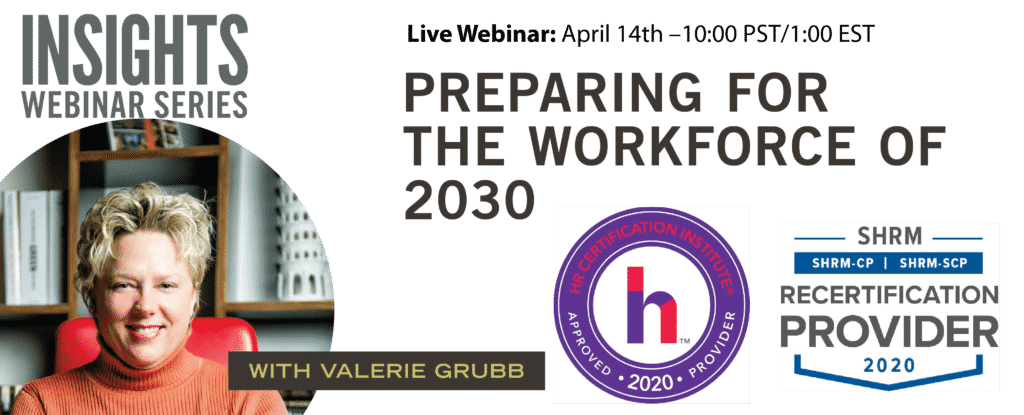Guest post by Valerie Grubb, President of Val Grubb & Associates, Ltd.
The long-heralded workforce of 2020 has arrived, which means that leaders now need to focus on preparing for the workforce of 2030 and what employment landscapes will look like in another decade. No one has a crystal ball that makes it possible to predict the future with 100 percent accuracy. But people who pay close attention to the employment and technology sectors of the business world have come up with some pretty good estimates about which key drivers will affect the workforce over the next ten years—and the role that company leaders will play in helping their organizations navigate them.
Generation Z
It seems that just yesterday the Millennials were on our doorstep. Today, this generation has fully integrated into the workforce, and the next generation is poised to make its grand debut.
Enter Generation Z, the cohort that has just begun to enter the workplace. It’s very different from its predecessors, though, so anyone who wants to manage this group well needs to throw out any assumptions about what it means to be a younger employee today.
I’ve written extensively about Generation Z elsewhere on my blog (see this post) and even wrote an entire book about how to manage different generations, so I’ll present just a few main points here. Overall, this generation is more diverse than any that preceded it; having grown up with technology, its members are the first true digital natives. Organizations will need to understand how to appeal to this group’s diverse interests and leverage their comfort with and widespread use of online technologies and social media. They will also need to figure out how to provide the meaning, ethics, and sense of purpose that the members of Generation Z want in their careers.
Automation
First, a quick look at the numbers: a recent McKinsey report found that about half “of current work activities are technically automatable through currently demonstrated technologies” and that three-fifths of “current occupations have more than 30 percent of their activities that are technically automatable.” At the same time, “very few occupations—less than 5 percent—consist of activities that can be fully automated.”
What does this signify? In short, it means that as automation is increasingly implemented between now and 2030, upwards of 800 million full-time employees could be displaced and as many as 375 million full-time employees will have to change occupations during that period. According to McKinsey, up to one-third of workers in the USA could be affected.
Some sectors will be more (or less) affected by automation:
Activities most susceptible to automation include physical ones in predictable environments, such as operating machinery and preparing fast food. Collecting and processing data are two other categories of activity that can increasingly be done better and faster with machines. Automation will have a lesser effect on jobs that involve managing people, applying expertise, and those involving social interactions, where machines are unable to match human performance for now. Jobs in unpredictable environments—occupations such as gardeners, plumbers, or providers of child- and elder-care—will also generally see less automation by 2030, because they are difficult to automate technically and often command relatively lower wages, which makes automation a less attractive business proposition.
In other words, although some jobs may become automated, overall employment rates might not change as dramatically if the workforce shifts to other tasks. Therefore, company leaders need to figure out how to help workers retrain so they can continue to have skill sets that meet the ever-changing demands of the market.
Data Analytics
More than ever, over the next decade, companies will need to learn how to use data analytics to predict performance and empower agile HR. As Josh Bersin puts it:
With the increased focus on measuring diversity, gender pay equity, skills gaps, labor utilization, retention rates, real-time feedback, and even organizational network analysis, CEOs and CHROs now understand that people analytics is a vital part of running a high performing company.
Fortunately, most organizations seem to recognize the importance of leveraging data analysis. In one recent Deloitte study, three-quarters of the companies surveyed said they were “planning on increasing investment in analytics capabilities over the next two years.” As the use of data analysis rises, so too will the demand for professionals in the high-paying field of data science.
Companies that want to be ready for the 2030 workforce need to analyze the maturity level of their data analytics capability. For example, one key question to ask is “Do our multiple data systems talk with one another?” Some of the different areas to measure (and tools to measure them) include:
- employee engagement (pulse surveys, continuous performance management tools)
- employee recognition (social recognition systems)
- employee communications and teamwork (organizational network analysis and e-mail metadata analysis systems)
- employee travel and location (time and expense trackers, employee badge readers, phone location data)
- employee well-being (voluntarily shared data about exercise and fitness, well-being applications)
- employee sentiment and trust (“mood analysis” of survey responses and e-mail)
Organizations must understand that their ability to implement real-time data collection goes hand in hand with employees’ expectations that this collection is immediately followed by answers and actions. In a world in which 24 hours is considered far too long to respond to an e-mail, companies will need to become increasingly agile to meet those expectations.
New Ways to Work
If they want to be ready for workforce 2030, organizations need to shift their focus from redesigning processes to reimagining how work is accomplished. For example, rapid innovations in communications technology now allow much work to be done anywhere—and that technology will only become easier to use and more widespread over the next ten years. The ability to work remotely isn’t just a matter of having a new-model laptop and a high-speed Internet connection, though. As workers increasingly move offsite, that shift can have a dramatic impact on how employees relate to their managers, to their colleagues, and to their clients. For this reason, HR—not IT—will need to spearhead the rollout of these solutions over the next decade.
Collaboration platforms and work-based social media, too, will take center stage in the future. Although much has been written about how younger employees favor texting, social-media-based messaging, and applications such as Slack over e-mail, for now, e-mail remains the standard for workplace communications. But that will change over the next decade as new communication technologies emerge and—perhaps more significantly—the workplace becomes increasingly filled with younger employees who have the numbers (and clout) to push the workplace toward non-e-mail communication formats.
Companies will need to ensure that managers are prepared (in terms of both mindset adjustments and practical training) to use collaboration platforms and social media to set goals and to motivate, engage, and develop their employees. This is especially true when dealing with offsite employees (whom managers might see only one or two times per year) but also holds true in more “traditional” work environments. At the same time, as organizations become increasingly hyperconnected, companies will need to conduct analyses on whether new communication tools actually improve the organizational, team, and individual performance.
Social Corporate Responsibility
I think CSR, corporate social responsibility, is something that is becoming front and center.
—Alan Patricof, American venture capitalist
Over the past few decades, national demographics and culture have changed dramatically. The population has become more diverse—and the workforce has as well. As a result, many companies have embraced practices and policies that reflect the evolving interests of their employees and clients, as a recent Deloitte study on corporations’ social capital found:
An organization’s track record of corporate citizenship and social impact now has a direct bearing on its core identity and strategy. Engagement on topics such as diversity, gender pay equity, income inequality, immigration, and climate change can lift financial performance and brand value, while failure to engage can destroy the reputation and alienate customers and potential employees.
As the political scene becomes more and more divisive, general confidence in the government’s ability to address certain social concerns is being shaken. As this trust diminishes, “citizens are looking to business to fill the void on critical issues such as income inequality, health care, diversity, and cybersecurity to help make the world more equal and fair.” For example, in January 2018 three American companies (Amazon, Berkshire Hathaway, and JP Morgan Chase) formed their own nonprofit healthcare organization, Haven, because they were “frustrated by the quality, service, and high costs that their employees and families have experienced in the U.S. health system” and could not count on the government to solve those problems.
As you work on your organization’s long-term plan to take it to 2030, think about what your company can do specifically to embrace and promote social corporate responsibility.
The Rise of HR
No matter what business you are in, there is change, and it’s happening pretty quickly.
—Jim Pattison, Canadian business magnate
So what does all of this mean for your company over the next ten years? Like it or not, changes are coming, and senior leaders need to help the business world prepare for them. It means that to stay relevant, companies must be at the forefront of change.
It’s also important to recognize that technology issues are no longer the exclusive domain of the IT department. HR needs a seat at the table whenever conversations take place about the implementation of technologies in the workplace. These technologies include data mining and analysis, automation, communication vectors, and telecommuting. (No doubt ten years from now that sentence should probably be edited to include new technologies that don’t exist today but will in 2030!)
Among all departments within a company, HR has the broad perspective and scope needed to be most effective at evaluating and implementing the practices that organizations will need to thrive—and perhaps even just to survive—in workforce 2030. Is your HR department positioned to lead this revolution? Time to start asking that question now.
To learn more, please join us on Tuesday, April 14th at 12:00 PM CDT (10:00 AM PST) for a Live Webinar with Val Grubb. This webinar is valid for 1 PDC toward SHRM-CP and SHRM-SCP recertification and has been pre-approved by HRCI for 1 HR (General) recertification credit hour. Click here to register.

